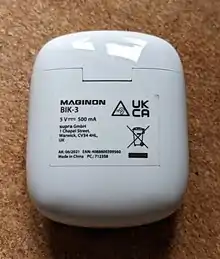| UKCA marking | |
|---|---|
 UKCA marking | |
 UK (NI) marking used to supplement CE marking for goods released on to the NI market | |
| Standards organization | Department for Business and Trade |
| Effective region | Great Britain (UKCA) Northern Ireland (UKNI) |
| Effective since | 2020 |
| Predecessor | CE marking |
| Product category | Various |
| Mandatory since | 1 January 2021[1] (de jure, not enforced.[2]) |
| Website | www |

UK Conformity Assessed (UKCA) marking is a conformity mark that indicates conformity with the applicable requirements for products sold within Great Britain.[3]
Applicability of UKCA and CE marks
The UKCA marking became part of UK law at the end of the Brexit transition period, on 31 December 2020, with the coming into force of The Product Safety and Metrology etc. (Amendment etc.) (EU Exit) Regulations 2019.[1][4][5] It has been mandatory since then but the CE mark was to be accepted as an alternative until 1 January 2022.[2] This deadline was extended to 31 December 2022, then to 1 January 2023, then to 31 December 2024; on 1 August 2023 the deadline was extended with the CE mark accepted indefinitely for most goods as a valid alternative.[6][7][8]
The scope and procedures of the UKCA scheme will initially follow those for CE marking but, the Government said that after 31 December 2020 the two schemes may diverge.[6] Initial guidance regarding UKCA marking was originally published by the Government of the United Kingdom in 2019 ahead of a potential no-deal Brexit but was subsequently withdrawn.[9]
Characteristics of UKCA marking
The height of the UKCA marking must be at least 5mm; it may be larger so long as the proportions are kept.[3] The marking should be "easily visible, legible, and [from 1 January 2023] permanently attached to the goods".
Northern Ireland
The UKCA marking only applies to products placed on the market in Great Britain. In Northern Ireland, a part of the United Kingdom that remains aligned to the European Single Market due to the Northern Ireland Protocol, CE marking continues to be required.[10] UK-resident bodies are no longer qualified to carry out CE mark conformity assessments for goods intended for the EU, but under the Northern Ireland Protocol they may do so for Northern Ireland. Where a UK body has carried out the assessment for goods intended for Northern Ireland, the product should display both the CE mark and a UKNI mark.[11] However, goods intended for export to the EU must be assessed by an EU-resident body and carry a CE mark (and must not carry the UKNI mark).[11][lower-alpha 1]
As part of the British Government's policy of "unfettered access" for "qualifying Northern Ireland goods"[lower-alpha 2] to be sold in Great Britain without restriction, goods may be sold in Great Britain using the relevant Northern Ireland markings and without any additional approvals that would be required for the UKCA marking.[11]
| Type of Good | Accepted Mark(s) |
|---|---|
| Goods placed on the market in Northern Ireland |
|
| Goods placed on the market in Great Britain |
|
| Qualifying goods from Northern Ireland placed on the market in Great Britain |
|
| Goods placed on the market in the European Economic Area |
|
See also
- Registration, Evaluation, Authorisation and Restriction of Chemicals#In non-EU countries for the proposed "UK REACH".
- European Committee for Standardization and European Committee for Electrotechnical Standardization: the UK remains a member of these European Standards bodies.[13]
Notes
References
- 1 2 "The Product Safety and Metrology etc. (Amendment etc.) (EU Exit) Regulations 2019". legislation.gov.uk. The National Archives. Retrieved 6 May 2022.
- 1 2 3 UK Government (2022-11-14). "Businesses to be given UK product marking flexibility".
- 1 2 "The Product Safety and Metrology etc. (Amendment etc.) (EU Exit) Regulations 2019: Schedule 33", legislation.gov.uk, The National Archives, SI 2019/696 (sch. 33), retrieved 2020-08-28
- ↑ Foster, Peter (20 July 2020). "Manufacturers urge government to clarify UK's new standards regime". Financial Times.
- ↑ "What Brexit holds for construction equipment manufacturers – The Future Regulatory Landscape". Construction Equipment Association. 2020-08-12. Archived from the original on 2021-10-21.
- 1 2 "CE marking guidance". UK Government. 1 August 2023. Click "See all updates" for the various revisions.
- ↑ UK Government (11 October 2023). "Using the UKCA marking". See previous update of 24 August 2021.
- ↑ Partridge, Joanna (August 2023). "UK to retain EU safety mark in latest Brexit climbdown". The Guardian.
- ↑ "Prepare to use the UKCA mark after Brexit". Department for Business, Energy & Industrial Strategy. 2 February 2019 [withdrawn on 30 January 2020]. Archived from the original on 2020-08-27.
{{cite web}}: CS1 maint: unfit URL (link) - ↑ "Placing manufactured goods on the market in Northern Ireland from 1 January 2021". Department for Business, Energy & Industrial Strategy. August 2023.
In Northern Ireland, EU conformity markings will continue to be used to show that goods meet EU rules after 1 January 2021. For most manufactured goods, this is the CE marking, but there are some other markings for specific products (such as the wheel marking or Pi mark).
- 1 2 3 4 "Using the UKNI marking". GOV.UK. Retrieved 20 August 2021.
- ↑ "The Definition of Qualifying Northern Ireland Goods (EU Exit) Regulations 2020". legislation.gov.uk. The National Archives. Retrieved 6 May 2022.
- ↑ "CEN and CENELEC agreement on UK membership safeguards compatibility of standards and seamless European market access". British Standards Institution. 28 June 2021. Retrieved 5 May 2022.